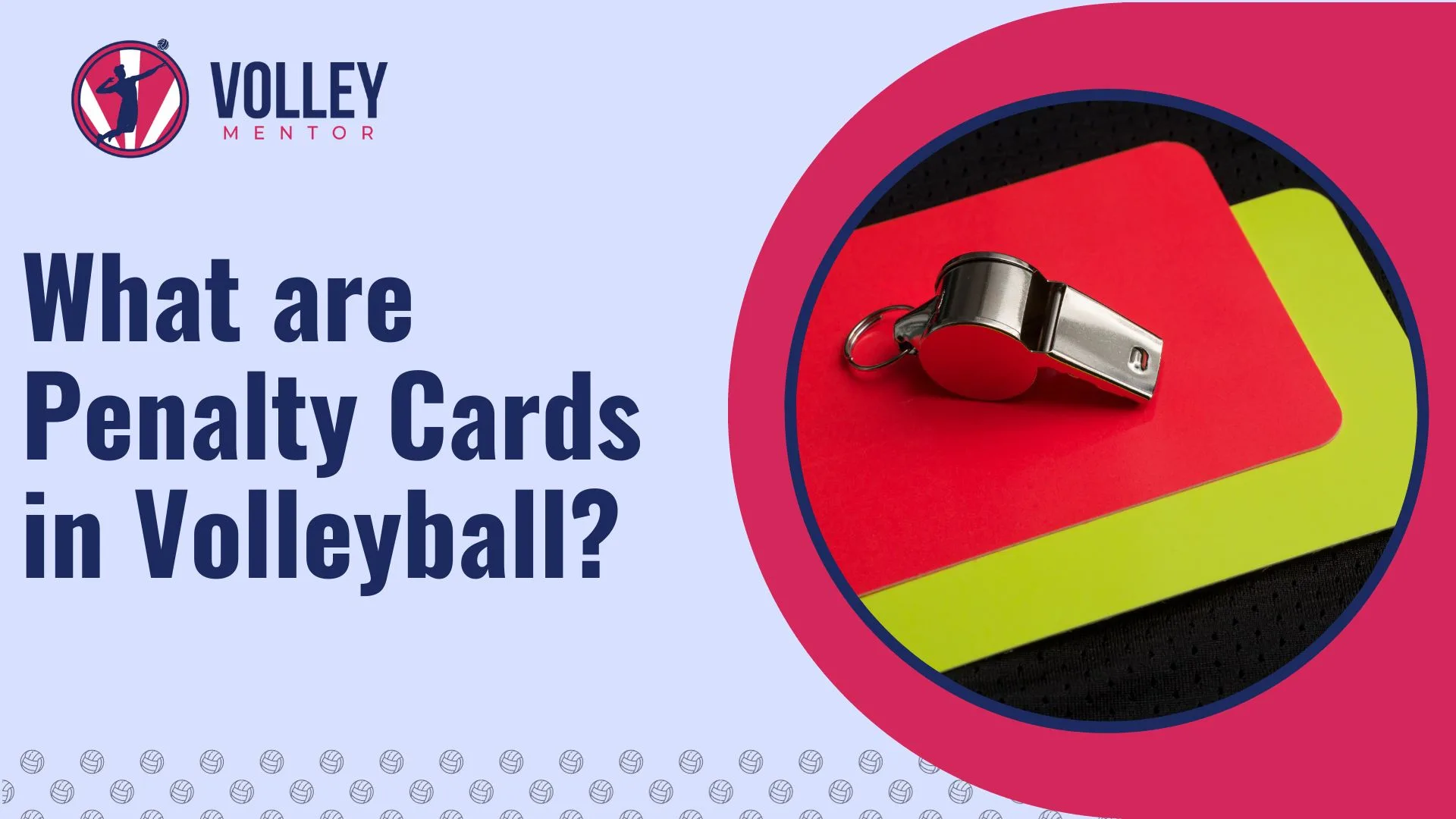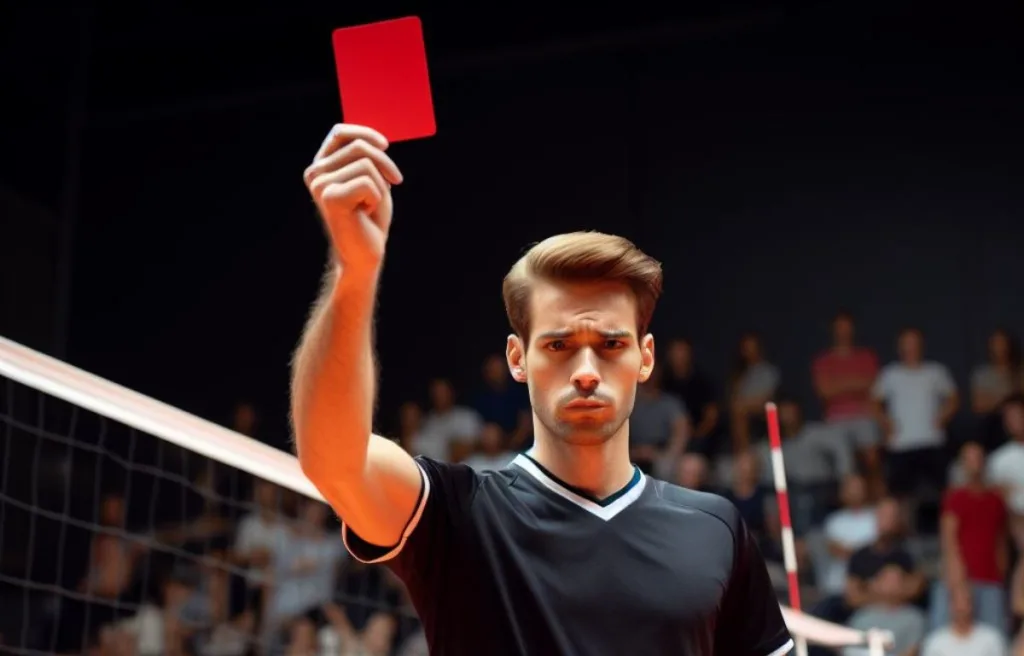What are Penalty Cards in Volleyball? (A Player’s Guide)

Have you ever wondered about those colorful cards referees wave around during a volleyball game?
You see, volleyball is all about incredible digs, exciting rallies, powerful spikes, and high vertical jumps.

But it also has a set of rules and guidelines that keep the game fair.
That’s where the cards come into play.
But what are volleyball penalty cards, and what are they used for?
Key Takeaway: Volleyball penalty cards are colorful indicators referees use to address misconduct during a match. The two primary penalty cards in volleyball are the yellow and red cards.
The yellow card issues a warning for misconduct, and the red card signifies a penalty, with the opposing team earning the point.
By the time I have covered this guide, you will not only understand the purpose of these cards.
But you will also get an idea of why they are essential in this fast-paced sport.
What Do The Cards Mean In Volleyball?
Referees use the penalty cards to maintain fairness and sportsmanship on the court.
There are commonly two types of cards in volleyball:
- Yellow Card
- Red Card
Let me put these cards into perspective for a better explanation.
Imagine a yellow card as a gentle reminder to the volleyball player to stay on the right path.
It’s a chance for the players and the team officials to improve their behavior.
In contrast, a red card is more like a stop sign.
It demands immediate attention and comes with significant consequences.
What Is A Yellow Card In Volleyball?
A yellow card, or caution card, is a visual warning from a referee to a player or a team official.
The referee gives the warning in response to minor misconduct or bad behavior that violates the volleyball game rules or the spirit of fair play.
While a yellow card is a cautionary measure, it doesn’t result in immediate expulsion or disqualification.
Instead, it serves as a clear warning to the player or team official to correct their behavior.
Remember that a yellow card has some consequences, too, as discussed below:
I have dedicated a section below on minor misconduct to help you better understand what the yellow card in volleyball means.

Minor Misconduct & its Consequences
Minor misconduct means the usage of verbal infractions like using bad words, arguing with your opponents, or disagreeing with the referee’s decisions.
It also includes minor physical contact that does not result in injury but still violates the rules.
When misconduct occurs by a volleyball player, it’s essential to understand the consequences or sanctions that follow.
Minor misconduct offenses don’t lead to sanctions, like expulsion or disqualification.
Although not very serious, these rule violations are still something the referee needs to watch out for.
The referee typically issues verbal warnings through the game captain when minor misconduct occurs.
In another case, the referee shows a yellow card as a cautionary measure, as discussed in the FIVB Rulebook, section 21.1.
It is recorded in the score sheet but has no immediate consequences.
You can think of it as a reminder to players and team officials to maintain sportsmanship.
Types of Misconduct
FIVB Official Rulebook has divided misconduct into three distinct categories.
Each category has its level of severity.
It provides a clear framework for assessing the seriousness of offenses.
These levels are helpful for referees to determine the appropriate response, which includes warnings, yellow cards, or red cards.
Let me elaborate on each category, referencing the FIVB RuleBook sections.
1) Rude Conduct (Reference: 21.2.1)
Rude conduct in volleyball refers to actions that are against the principles of moral standards.
It involves disrespectful or offensive behavior towards teammates, opponents, officials, or spectators.
2) Offensive Conduct (Reference: 21.2.2)
Offensive Conduct takes misconduct a step further.
It involves insulting words, gestures, or any action that expresses contempt.
This misconduct goes beyond rudeness and involves behavior that offends or insults others involved in the game.
Such behavior by a player affects the spirit of sportsmanship and fair play.
3) Aggression (Reference: 21.2.3)
Aggression is the most severe form of misconduct in volleyball.
FIVB describes it as the actual physical attack or threatening behavior towards anyone on the court.
Such an aggressive attitude has no place in the game and significantly risks the sport’s safety.
Level of Sanctions in Volleyball
You may wonder why I have yet to talk about the Red Card.
I know your concern, but before talking about it, it is crucial to explain the sanctions’ levels.
You have already read the misconduct categories above.
But what about the consequences of those behaviors?
Well, FIVB has outlined three stages of sanctions.
I am explaining each stage in detail, and after that, understanding the Red Card usage will be much easier for you.
Stage 1: Penalty
The initial stage of sanction is called a ‘penalty.’
If a player shows rude conduct for the first time in a match, it leads to a penalty (reference: 21.2.1, FIVB Rulebook).
As a result, the opposing team gains a point and the opportunity to serve.
The 1st referee issues it to a player based on the seriousness of the offense.
Stage 2: Expulsion
Expulsion is the 2nd stage of the sanctions levels and is more severe than a penalty.
If a team member faces expulsion, the team must replace them through legal or exceptional means.
He is not allowed to participate for the rest of the set.
The player must go to the dressing room until the team completes the set.
This rule also applies to the expelled coach, who loses the right to interfere in the ongoing set and must go to the dressing room until the completion of the set.
There is something important that I want to mention here.
If a team member commits offensive conduct, it straightforwardly leads to expulsion.
On the other hand, if a team member does rude conduct twice in the exact match, that also results in expulsion.
Stage 3: Disqualification
The most severe level of sanction is “disqualification.”
Any team member subjected to such sanction can’t participate for the rest of the match.
Also, like expulsion, he is substituted legally and must go to the dressing room.
Some of the causes of disqualification include:
What is a Red card in volleyball?
A red card in volleyball represents the penalty by a player.
It results in the immediate loss of the point for the offending team.
It is the initial step of the FIVB sanctions level.
You can call it the lightest offense in the sanctions phase.

Typically, a player receives a red card after accumulating two yellow cards in a match.
He is allowed to continue playing the match after receiving the red card.
Sometimes, the player is expelled from the set or disqualified from the match.
But such scenarios only occur when the referee shows the red and yellow cards together.
Don’t get confused!
I will explain such scenarios in the next section to give you a complete insight.
When are Yellow and Red cards shown together?
When the referee shows the yellow and red cards together in one hand, the player gets expelled from the set and is substituted legally.
It is the second stage of the sanction levels defined by FIVB.
The expulsion rules immediately apply to either the offending player or the coach.
As discussed above, the referee’s gesture of holding both cards together is a clear signal of expulsion.
The player can only return to the match once the set has concluded.

In another scenario, the referee holds the yellow card in one hand and the red card in his other hand.
It is an indication of the disqualification of the player.
It is the last stage of the sanction level, resulting in the player’s dismissal for the rest of the match.
The player is also substituted immediately on the court and goes straight to the dressing room.

You might see such gestures rarely from the referee.
One of the leading causes of disqualifications is the player’s physical attack or highly aggressive behavior.
In extreme cases, officials may disqualify the player for the rest of the tournament matches.
But it depends on the offense’s severity and the tournament’s rules.
What is a Green Card in Volleyball?
The concept of a green card in volleyball is relatively new and has a specific and positive purpose.
It was introduced as part of a fair play initiative in 2023.
This initiative aims to promote honesty among players and streamline the game by reducing the need for video challenges.
Volleyball Nations League (VNL) Finals and some high school leagues have started adopting this approach, and I believe its positive impact will lead to broader adoption in the future.
Let me explain the purpose of the green card below:
During a volleyball match, if a player commits a violation like touching the net, blocking the serve, etc, the referees may not always see them.
In the past, this could lead to disputes or the need for a video review to determine the truth.
The green card changes this dynamic.
Referees now use this card to recognize players who voluntarily admit to their faults.
For instance, if a player knows they touched the net and admits it, the referee shows a green card.
This act acknowledges the player’s honesty and saves time by avoiding unnecessary video reviews.
Strategies to avoid Volleyball Penalty Cards
Nobody, whether a player or coach, wants to experience the frustration of receiving volleyball penalty cards.
It not only shakes a player’s confidence but also puts their reputation on the line, especially in a sport as hard as volleyball.
I am sharing some valuable tips to help you avoid this hassle.
Final Words
In our journey through volleyball penalty cards, I hope you have learned about the usage of yellow and red cards, minor misconduct, their consequences, and the level of sanctions.
I also discussed the green card, a new way to encourage fair play and good sportsmanship.
Thank you for staying with me, but I want to remind you of one thing.
Volleyball is more than just rules and cards.
Although the penalty cards, whether yellow or red, add a bit of drama, they occur more rarely than a routine.
So, as you step into the court, it’s all about teamwork, respect, and having fun.
Penalties might come and go, but remember your love for the game and fair play at the forefront of your volleyball journey.
Let the joy of volleyball shine through in every match.
